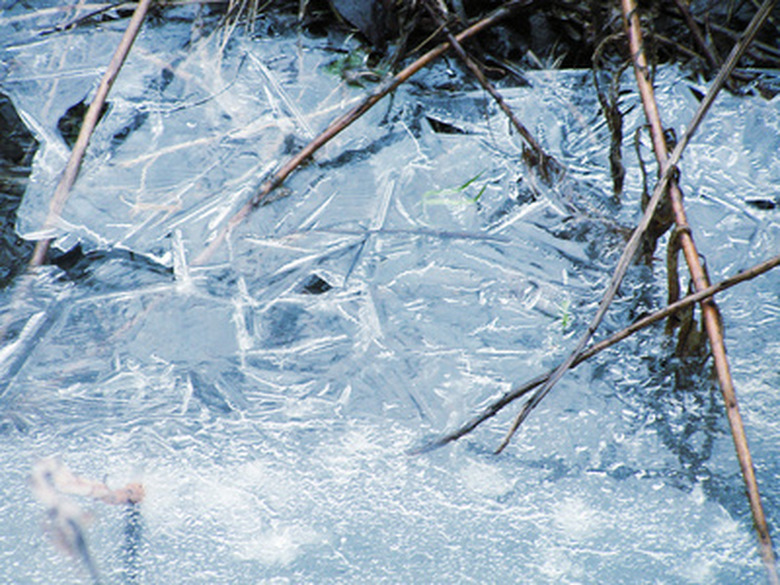How To Determine The Density Of Ice
Density is a measure of how tightly the molecules in a substance are packed together. In other words, it is the amount of mass in a given unit of volume. A substance usually has only one density, which may differ slightly with temperature. Different pieces of gold, for example, might have different weights or different volumes, but the ratio between these quantities, the density, remains constant. You can look up the densities of many substances, or you can calculate it yourself experimentally. Finding mass is as easy as weighing the object. Volume is harder. There are two basic ways of finding it: measuring, which only works for regular shapes, or using the object to displace water.
Ice With a Regular Shape
Step 1
Fill the square or rectangular container about eight- or nine-tenths full of water, and place it in the freezer. Don't use a container unless it's OK for it to break — this might not happen, but it is possible. The bigger the container, the better, since your errors will be comparatively smaller with a larger mass.
Step 2
Take the container out of the freezer and place it upside down. Hit it to dislodge the ice. Let it thaw a bit if it doesn't come out right away.
Step 3
Measure the length, width, and height of the block of ice. Do this quickly to avoid excessive melting.
Step 4
Multiply the three numbers together to get the volume. If you measured in inches, the result is cubic inches. If you measured in centimeters, the result is cubic centimeters.
Step 5
Weigh the block of ice.
Step 6
Divide the weight by the volume to determine the density. The units of the result depend on the units you measured with. If you weighed in pounds and measured in inches, the result is pounds per cubic inch. If you weighed in grams and measured in centimeters, the result is grams per cubic centimeter.
Ice With an Irregular Shape
Step 1
Place an empty container inside a larger empty container, such as a mug inside of a pot. The smaller container must be big enough to hold your entire piece of ice.
Step 2
Fill the smaller container to the very brim with water, so that it would start spilling if you added any more water.
Step 3
Weigh your chunk of ice, using a scale or a balance.
Step 4
Place the chunk of ice in the smaller container, so that the water spills over the sides. Do this gently to avoid splashing. A bit of the ice will be floating above the water. Push it down using your finger or something thinner, like a pencil or even a needle, so that the ice is totally submerged. Avoid putting your finger, or whatever object you use, under the water.
Step 5
Collect all the water that spilled into the larger container and pour it into a graduated cylinder or measuring cup.
Step 6
Look at the volume of water that was displaced. Estimate if you have to. This is the volume of your ice. One milliliter is equal to one cubic centimeter, so simply divide the weight of the ice by this volume to get the density in pounds, ounces or grams per cubic centimeter, depending on the units of your scale.
Things Needed
- Square or rectangular container
- Ruler
- Accurate scale or balance
- Large and small container
- Graduated cylinder or measuring cup
Cite This Article
MLA
Moll, Eric. "How To Determine The Density Of Ice" sciencing.com, https://www.sciencing.com/determine-density-ice-7817242/. 24 April 2017.
APA
Moll, Eric. (2017, April 24). How To Determine The Density Of Ice. sciencing.com. Retrieved from https://www.sciencing.com/determine-density-ice-7817242/
Chicago
Moll, Eric. How To Determine The Density Of Ice last modified March 24, 2022. https://www.sciencing.com/determine-density-ice-7817242/
